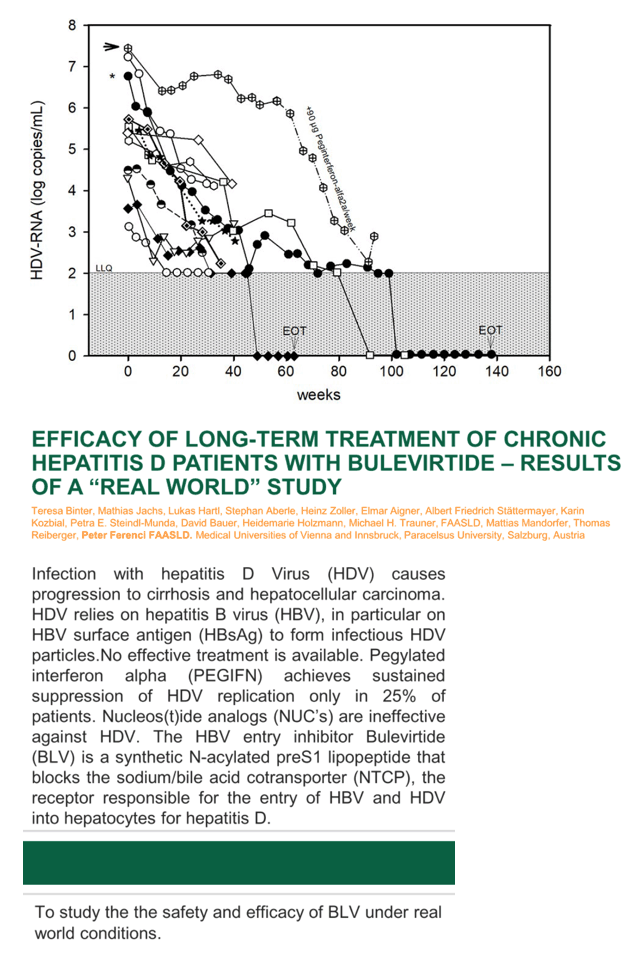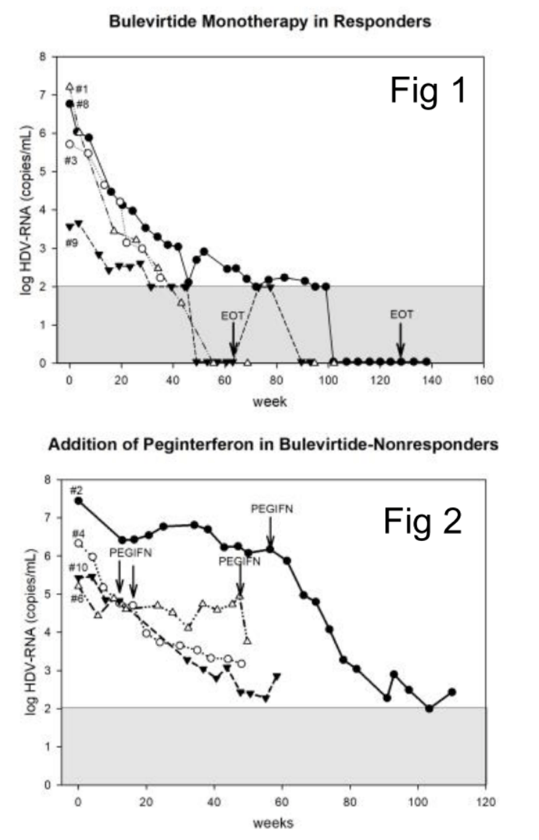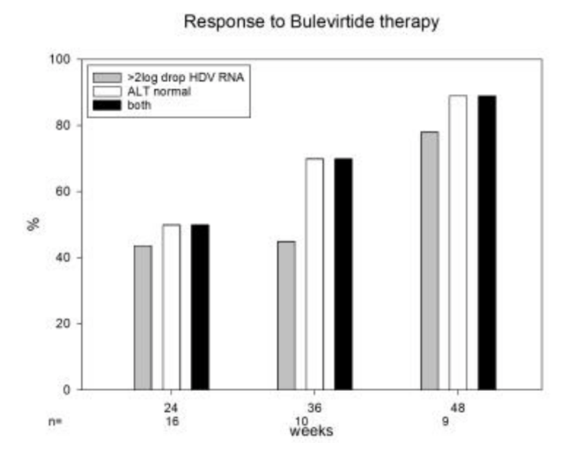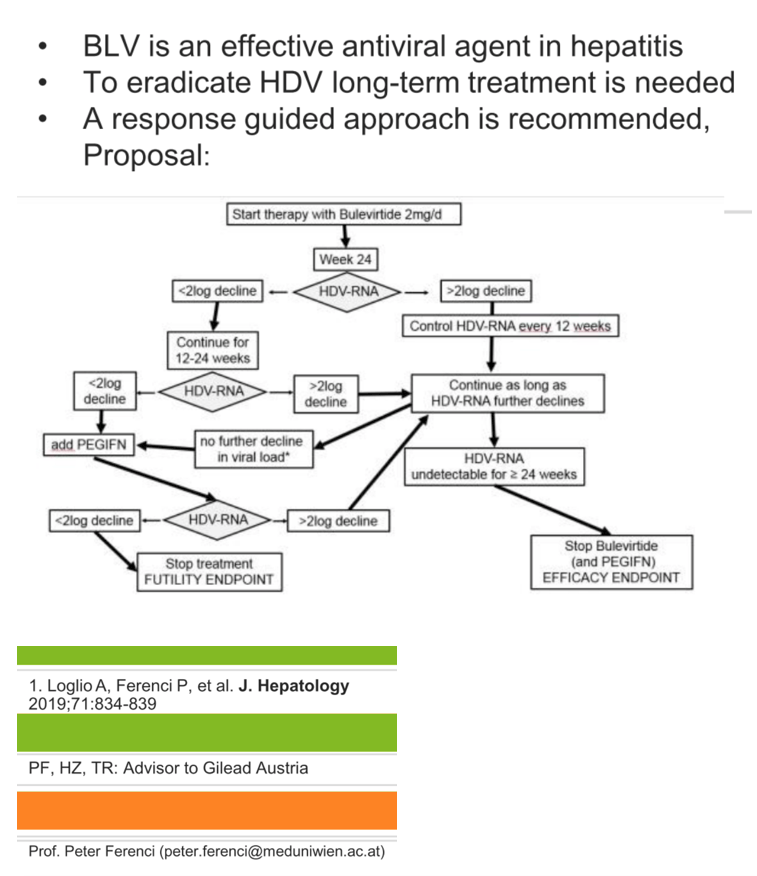 |
 |
 |
| |
EFFICACY OF LONG-TERM TREATMENT OF CHRONIC HEPATITIS D
PATIENTS WITH BULEVIRTIDE - RESULTS OF A "REAL WORLD" STUDY
|
| |
| |
AASLD 2021 Nov 12-15
Teresa Binter1, Mathias Jachs2, Lukas Hartl2, Stephan
Aberle3, Heinz Zoller4,5, Elmar Aigner6, Albert Friedrich Stättermayer7, Karin Kozbial7, Petra E. Steindl-Munda8, David Bauer7, Heidemarie Holzmann9, Michael H. Trauner7, Matthias Mandorfer10, Thomas Reiberger7 and Peter Ferenci7,
(1)Division of Gastroenterology & Hepatology, Department of Internal Medicine III, Medical University of Vienna, (2)Division
of Gastroenterology & Hepatology, Department of Internal Medicine III, Medical University of Vienna, Vienna, Austria, (3) Center of Virology, Medical University of Vienna, Austria, (4) Department of Internal Medicine I, Medical University Innsbruck, Innsbruck, Austria, (5)Mediac, (6)First Department of Medicine, Paracelsus Medical University Salzburg, (7) Division of Gastroenterology and Hepatology, Department of Internal Medicine III, Medical University of Vienna, (8) Department of Medicine III, Division of Gastroenterology and Hepatology, Medical University of Vienna, (9)Center for Virology, Medical University of Vienna, (10)Department of Internal Medicine III, University Hospital Vienna
abstract
Background: Bulevirtide (BLV) blocks the uptake of the hepatitis D Virus (HDV) into hepatocytes via sodium/bile acid cotransporter. BLV was conditionally approved by EMA but real-life data on BLV efficacy are limited.
Methods: MyrPharma (Leipzig/Germany) provided BLV in a compassionate use program until 8/2020, and thereafter prescribed through the Austrian health insurance. HDV-RNA was determined by PCR (according le Gal et.al,J.Clin Microbiol 2005; LLQ:100 copies/mL). BLV dose and treatment duration was at the discretion of the investigator. It is planned to terminate treatment after HDV-RNA being undetectable for 6 months.
Results: 15 patients (m/f:6/9; mean age: 50.2 years; 9 [60%] compensated cirrhosis) received BLV (2mg/d in 12; 10 mg/d in 2), 14 as initial monotherapy. 13 patients were PEGIFN nonresponders, 2 were recently diagnosed patients. During BLV monotherapy, 13/14 had at least a 1-log HDV-RNA decline, including 3 with undetectable HDV-RNA and 1 with a decrease to LLQ (figure). BLV treatment was terminated as planned in 2 patients with undetectable HDV-RNA for >6 months. One non-cirrhotic patient received BLV 10mg/d for 108 weeks, tapered to 5mg/d and 2mg/d, respectively, over the next 36 weeks. From week 96 on, HDV-RNA was and remained undetectable 20 weeks after therapy. One other patient (compensated cirrhosis) received 2mg/d BLV for 63 weeks, HDV-RNA was undetectable for 6 months, but HDV-RNA became detectable after 4 weeks. Two patients dropped out due to noncompliance after 8 and 24 weeks, respectively. Eleven patients are still on treatment (24 to 140 weeks of therapy). Of note, in a patient (arrow) with <1log decline of HDV-RNA on BLV (starting with 2mg/d and increased to 10mg/d for a total of 54 weeks), adding PEG-Interferon-alfa2a (PEGIFN, 90µg/week) lead to a rapid decline of HDV-RNA (total treatment 93 weeks). In a further patient, HDV-RNA had declined on PEGIFN by 3-log and after addition of BLV, the patient became HDV-RNA negative (not shown in figure). Two became negative (at weeks 90 and 128, respectively), one at LLQ at week 30, one had a >4-log decline (currently week 40). one a >3-log decline (week 30), 4 had a maximum decline of 1-log (week 40, 30, 32 and 24). ALT levels normalized in 11 (84.6%) patients. During BLV therapy HBsAg changes levels did not change and bile acid levels increased without pruritus.
Conclusion: BLV is effective in decreasing HDV-RNA and ALT. Optimal treatment duration to achieve sustained HDV suppression has not been established yet, but it should likely exceed one year. Treatment was well tolerated. The data clearly show the need for an individualized approach when treating patients with chronic hepatitis D with BLV. Figure: HDV-RNA changes on treatment with BLV. * The first 48 weeks of this patient were published (Loglio et al, J. Hepatology 2019); EOT= end of treatment.





|
| |
|
 |
 |
|
|